
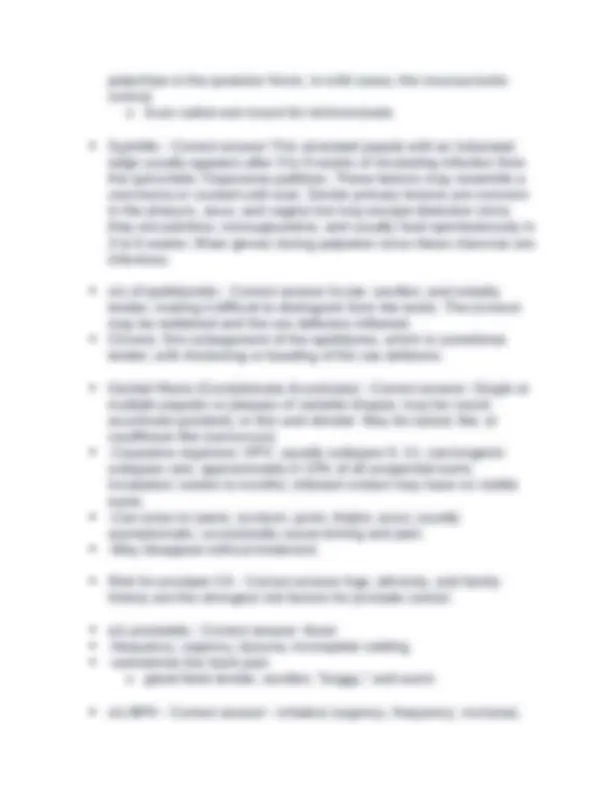
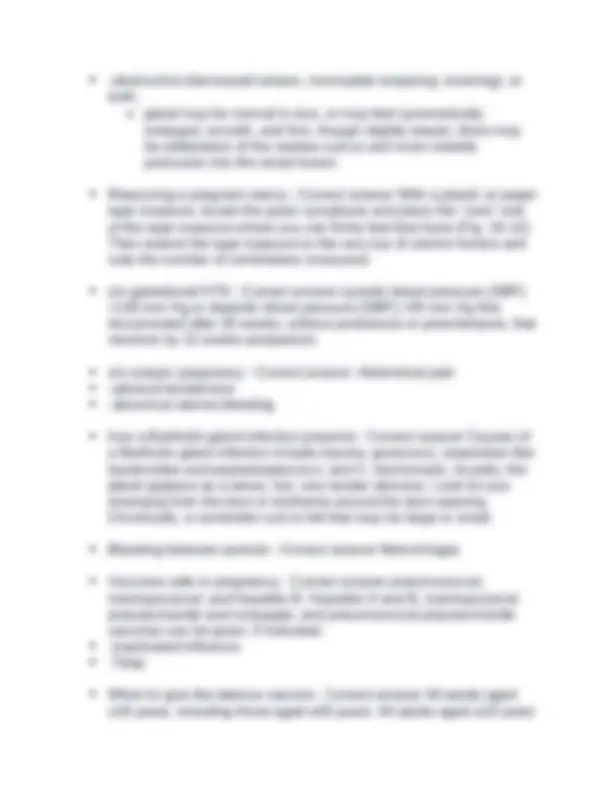
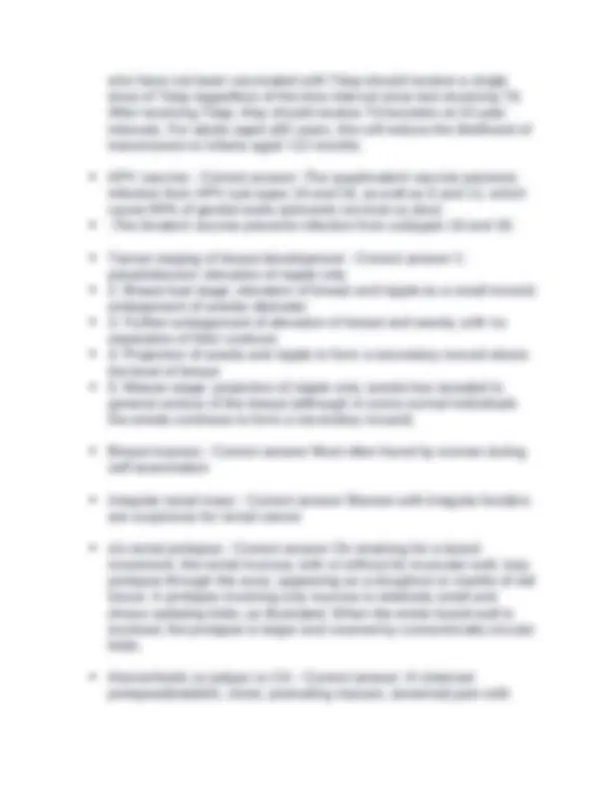
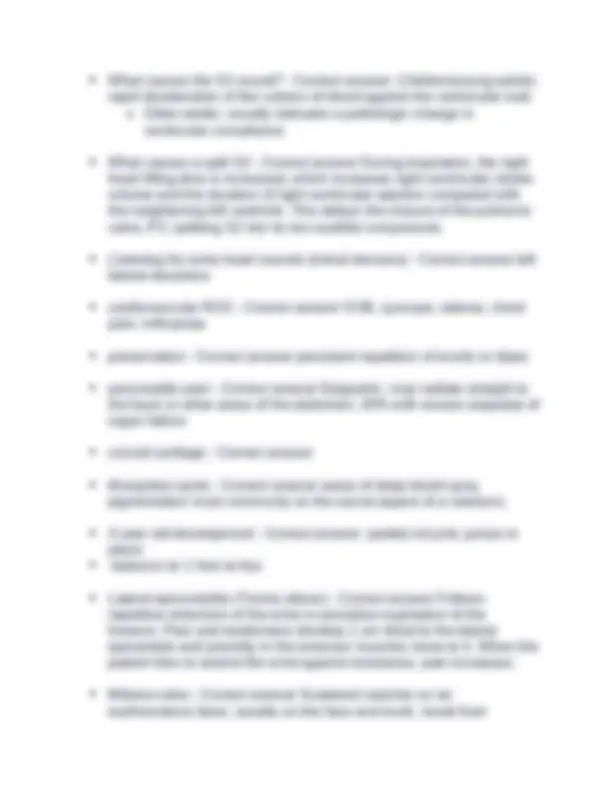
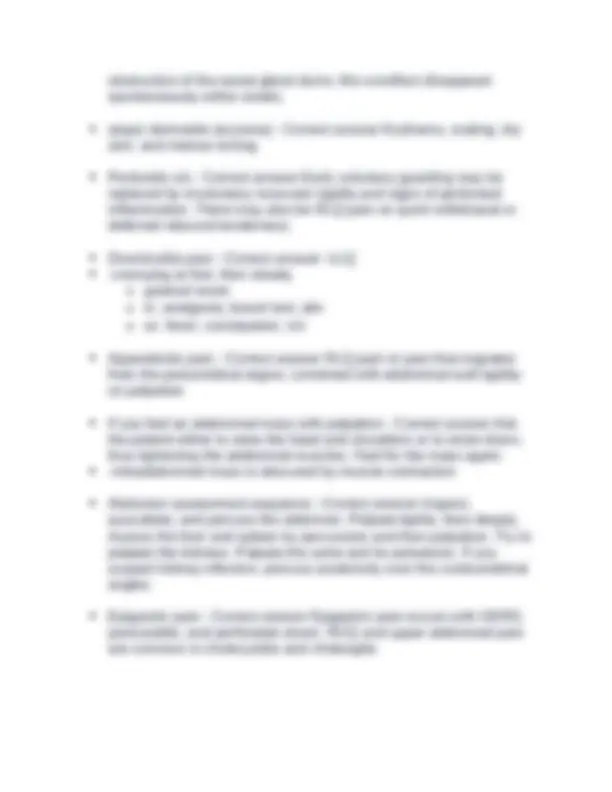
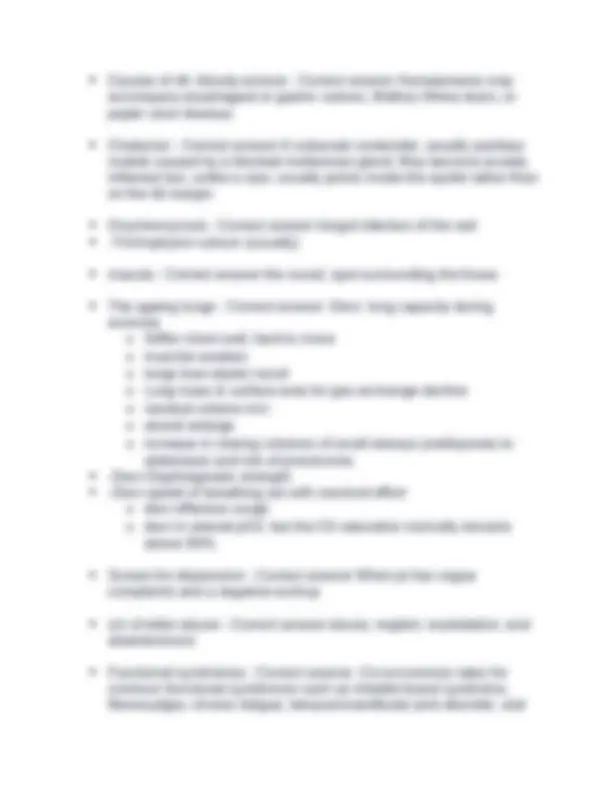


Study with the several resources on Docsity

Earn points by helping other students or get them with a premium plan


Prepare for your exams
Study with the several resources on Docsity

Earn points to download
Earn points by helping other students or get them with a premium plan
Community
Ask the community for help and clear up your study doubts
Discover the best universities in your country according to Docsity users
Free resources
Download our free guides on studying techniques, anxiety management strategies, and thesis advice from Docsity tutors
Correct answers to questions related to breast and gynecological health, including symptoms of various conditions, risk factors, and diagnostic methods. It is intended for use in examinations for medical students or healthcare professionals.
Typology: Exams
1 / 11

This page cannot be seen from the preview
Don't miss anything!







Suspicious breast mass - Correct answer -A mobile mass that becomes fixed when the arm relaxes is attached to the ribs and intercostal muscles; if fixed when the hand is pressed against the hip, it is attached to the pectoral fascia. -Hard irregular poorly circumscribed nodules, fixed to the skin or underlying tissues, strongly suggest cancer Risk for Breast cancer - Correct answer --Age -family history of breast/ovarian CA o inherited genetic mutations, -personal history of breast cancer o high levels of endogenous hormones o breast tissue density o proliferative lesions with atypia on breast biopsy, - duration of unopposed estrogen exposure related to early menarche -age of first full-term pregnancy o late menopause. o breastfeeding for less than 1 year, o postmenopausal obesity -cigarette smoking, alcohol ingestion, o physical inactivity, and type of contraception. Characteristics of a breast cyst - Correct answer Soft to firm, round, mobile, often tender. The best way to examine the lateral portion of the breast - Correct answer -Have pt roll onto the opposite hip -place her hand on her forehead. o keep shoulders pressed against the bed
-palpate in the axilla, moving in a straight line down to the bra line, then move the fingers medially and palpate in a vertical strip up the chest to the clavicle. Continue in vertical overlapping strips until you reach the nipple Bacterial Vaginosis (BV) - Correct answer -Caused by overgrowth of anaerobic bacteria (often from sex) o Discharge: Gray or white, thin, homogenous, malodorous, coats the vaginal walls, usually not profuse, may be minimal o Fishy/musty genital odor -Normal vulva and vaginal mucosa -Scan saline wet mount for clue cells (epithelial cells with stippled borders); sniff for fishy odor after applying KOH ("whiff test"); test the vaginal secretions for pH > 4. Candidal Vaginitis - Correct answer -Cause: Candida albicans, a yeast (normal overgrowth of vaginal flora); many factors predispose, including antibiotic therapy -Discharge: white and curdy, may be thin but usually thick, not as profuse as trichomonal infection, not malodorous o vaginal soreness, pruritus, pain on urination, dyspareunia (painful intercourse) -The vulva and surrounding skin are inflamed and sometimes swollen to a variable extent; the vaginal mucosa is reddened, with white tenacious patches of discharge; the mucosa may bleed when these patches are scraped off; in mild cases, the mucosa looks normal -Scan potassium hydroxide (KOH) preparation for the branching hyphae of Candida Trichomonal Vaginitis - Correct answer -Trichomonas vaginalis, a protozoan; often but not always acquired sexually o Discharge:Yellowish green or gray, possibly frothy; often profuse and pooled in the vaginal fornix; may be malodorous -Pruritus (though not usually as severe as with Candida infection); pain on urination (from skin inflammation or possibly urethritis); dyspareunia -Vestibule and labia minora may be erythematous; the vaginal mucosa may be diffusely reddened, with small red granular spots or
-obstructive (decreased stream, incomplete emptying, straining), or both, o gland may be normal in size, or may feel symmetrically enlarged, smooth, and firm, though slightly elastic; there may be obliteration of the median sulcus and more notable protrusion into the rectal lumen. Measuring a pregnant uterus - Correct answer With a plastic or paper tape measure, locate the pubic symphysis and place the "zero" end of the tape measure where you can firmly feel that bone (Fig. 19-12). Then extend the tape measure to the very top of uterine fundus and note the number of centimeters measured. s/s gestational HTN - Correct answer systolic blood pressure (SBP)
140 mm Hg or diastolic blood pressure (DBP) >90 mm Hg first documented after 20 weeks, without proteinuria or preeclampsia, that resolves by 12 weeks postpartum. s/s ectopic pregnancy - Correct answer -Abdominal pain -adnexal tenderness -abnormal uterine bleeding how a Bartholin gland infection presents - Correct answer Causes of a Bartholin gland infection include trauma, gonococci, anaerobes like bacteroides and peptostreptococci, and C. trachomatis. Acutely, the gland appears as a tense, hot, very tender abscess. Look for pus emerging from the duct or erythema around the duct opening. Chronically, a nontender cyst is felt that may be large or small. Bleeding between periods - Correct answer Metrorrhagia Vaccines safe in pregnancy - Correct answer pneumococcal, meningococcal, and hepatitis B. Hepatitis A and B, meningococcal polysaccharide and conjugate, and pneumococcal polysaccharide vaccines can be given, if indicated. -inactivated influenza -Tdap When to give the tetanus vaccine - Correct answer All adults aged ≥19 years, including those aged ≥65 years: All adults aged ≥19 years
who have not been vaccinated with Tdap should receive a single dose of Tdap regardless of the time interval since last receiving Td. After receiving Tdap, they should receive Td boosters at 10-year intervals. For adults aged ≥65 years, this will reduce the likelihood of transmission to infants aged <12 months. HPV vaccine - Correct answer -The quadrivalent vaccine prevents infection from HPV sub-types 16 and 18, as well as 6 and 11, which cause 90% of genital warts (prevents cervical ca also) -The bivalent vaccine prevents infection from subtypes 16 and 18. Tanner staging of breast development - Correct answer 1: preadolescent- elevation of nipple only 2: Breast bud stage: elevation of breast and nipple as a small mound; enlargement of areolar diameter 3: Further enlargement of elevation of breast and areola, with no separation of their contours 4: Projection of areola and nipple to form a secondary mound above the level of breast 5: Mature stage: projection of nipple only; areola has receded to general contour of the breast (although in some normal individuals the areola continues to form a secondary mound) Breast masses - Correct answer Most often found by women during self examination Irregular rectal mass - Correct answer Masses with irregular borders are suspicious for rectal cancer s/s rectal prolapse - Correct answer On straining for a bowel movement, the rectal mucosa, with or without its muscular wall, may prolapse through the anus, appearing as a doughnut or rosette of red tissue. A prolapse involving only mucosa is relatively small and shows radiating folds, as illustrated. When the entire bowel wall is involved, the prolapse is larger and covered by concentrically circular folds. Hemorrhoids vs polyps vs CA - Correct answer -H-(internal- prolapsed)reddish, moist, protruding masses, (external) pain with
Pulsations not eliminated by pressure on veins at sternal end of clavicle Height of pulsations unchanged by position Height of pulsations not affected by inspiration Cause of incr JVP - Correct answer -acute and chronic heart failure -tricuspid stenosis -chronic pulmonary hypertension -superior vena cava obstruction -cardiac tamponade -constrictive pericarditis Listening for Aortic Regurgitation - Correct answer Sitting, leaning forward, after full exhalation Listening to the apex of the heart - Correct answer Mitral s/s of thrombophlebitis - Correct answer Local swelling, redness, warmth, and a subcutaneous cord signal superficial thrombophlebitis, an emerging risk factor for DVT Buerger test (chronic arterial insufficiency) - Correct answer - Raise both legs to about 90o for up to 2 minutes o Then pt sits up with feet to the floor o see how long it takes for color to return to feet (usually 10- seconds) S/S of a venous insufficiency ulcer - Correct answer -edema, reddish pigmentation and purpura, venous varicosities, the eczematous changes of stasis dermatitis (redness, scaling, and pruritus), and at times cyanosis of the foot when dependent. Gangrene is rare -Borders are irregular, flat, or slightly steep. Why venous insufficiency causes ulceration - Correct answer chronic obstruction and incompetent valves in the deep venous system What do you feel when palpating the chest - Correct answer right ventricle
What causes the S3 sound? - Correct answer -Children/young adults: rapid deceleration of the column of blood against the ventricular wall. o Older adults: usually indicates a pathologic change in ventricular compliance. What causes a split S2 - Correct answer During inspiration, the right heart filling time is increased, which increases right ventricular stroke volume and the duration of right ventricular ejection compared with the neighboring left ventricle. This delays the closure of the pulmonic valve, P2, splitting S2 into its two audible components. Listening for extra heart sounds (mitral stenosis) - Correct answer left lateral decubitus cardiovascular ROS - Correct answer SOB, syncope, edema, chest pain, orthopnea preservation - Correct answer persistent repetition of words or ideas pancreatitis pain - Correct answer Epigastric, may radiate straight to the back or other areas of the abdomen; 20% with severe sequelae of organ failure cricoid cartilage - Correct answer Mongolian spots - Correct answer areas of deep bluish-gray pigmentation most commonly on the sacral aspect of a newborn. 3 year old development - Correct answer -pedals tricycle, jumps in place. -balance on 1 foot at 4yo Lateral epicondylitis (Tennis elbow) - Correct answer Follows repetitive extension of the wrist or pronation-supination of the forearm. Pain and tenderness develop 1 cm distal to the lateral epicondyle and possibly in the extensor muscles close to it. When the patient tries to extend the wrist against resistance, pain increases. Miliaria rubra - Correct answer Scattered vesicles on an erythematous base, usually on the face and trunk, result from
Causes of dk. bloody emesis - Correct answer Hematemesis may accompany esophageal or gastric varices, Mallory-Weiss tears, or peptic ulcer disease. Chalazion - Correct answer A subacute nontender, usually painless nodule caused by a blocked meibomian gland. May become acutely inflamed but, unlike a stye, usually points inside the eyelid rather than on the lid margin. Onychomycosis - Correct answer fungal infection of the nail -Trichophyton rubrum (usually) macula - Correct answer the round, spot surrounding the fovea The ageing lungs - Correct answer -Decr. lung capacity during exercise o Stiffer chest wall, hard to move o muscles weaken o lungs lose elastic recoil o Lung mass & surface area for gas exchange decline o residual volume incr. o alveoli enlarge o increase in closing volumes of small airways predisposes to atelectasis and risk of pneumonia. -Decr Diaphragmatic strength -Decr speed of breathing out with maximal effort o decr effective cough o decr in arterial pO2, but the O2 saturation normally remains above 90%. Screen for depression - Correct answer When pt has vague complaints and a negative workup s/s of elder abuse - Correct answer abuse, neglect, exploitation, and abandonment. Functional syndromes - Correct answer -Co-occurrence rates for common functional syndromes such as irritable bowel syndrome, fibromyalgia, chronic fatigue, temporomandibular joint disorder, and
multiple chemical sensitivity reach 30% to 90%, depending on the disorders compared -The prevalence of symptom overlap is high in the common functional syndromes namely, complaints of fatigue, sleep disturbance, musculoskeletal pain, headache, and gastrointestinal problems. -The common functional syndromes also overlap in rates of functional impairment, psychiatric comorbidity, and response to cognitive and antidepressant therapy. 8mo old child development - Correct answer -say dada/mama o indicate wants -feeds self -sit -cant stand Retracted TM with effusion - Correct answer looks like air bubbles